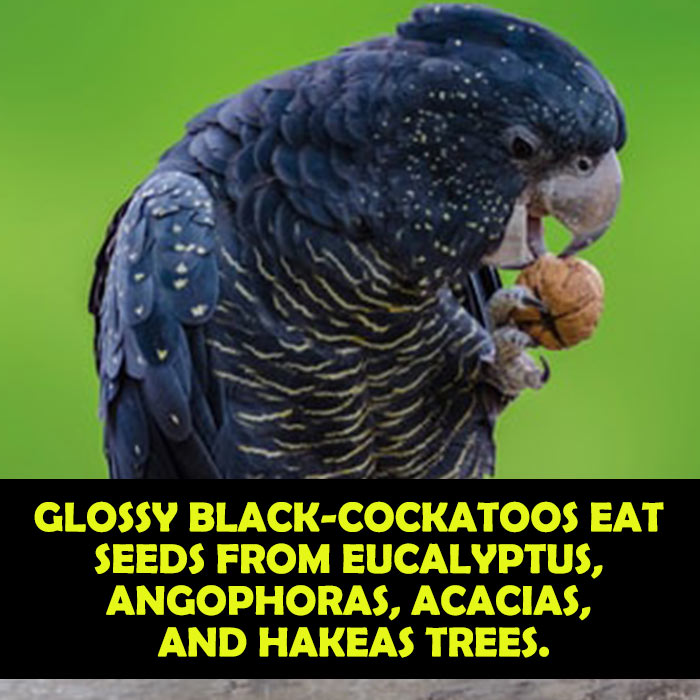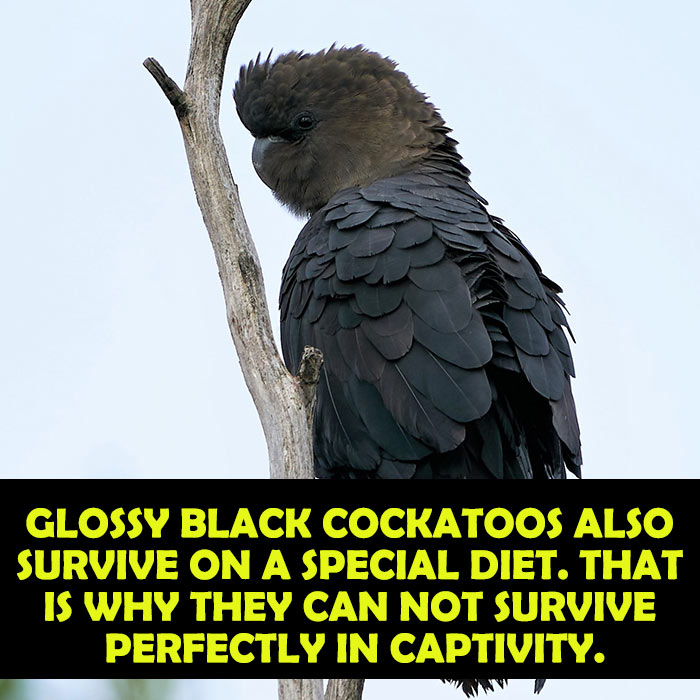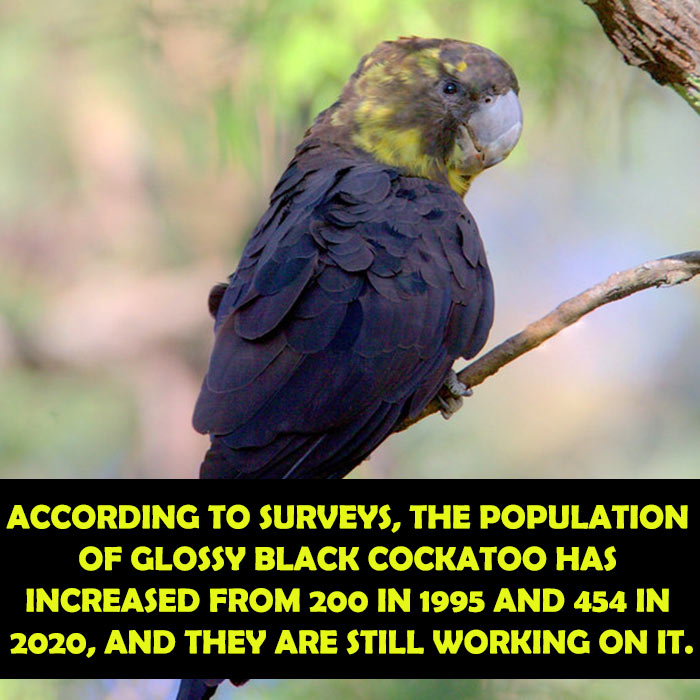The Glossy black cockatoo is the smallest subspecies of cockatoo from the Eastern part of Australia. Dutch naturists first describe these. The Glossy black cockatoos live on the kangaroo island and feed almost on the seeds of the drooping she-oak.
The Glossy black cockatoo nests in the hollows of large old-age species of Eucalyptus. These parrots are highly sensitive to changes in the quality and amount of she-oak seeds. Glossy black cockatoo exists at that place where drooping she-oak is plentiful.
Glossy black cockatoos are less social and quieter in nature.
Scientific classification of Glossy Black cockatoo:
- Scientific name: Calyptorhynchus Latham
- Family: Cacatuidae
- Order: Psittaciformes
Generally, they travel in small groups consisting of 2 or 3 birds. Glossy black cockatoos are different from their relative species (yellow-tailed and red-tailed black cockatoo). Glossy black cockatoos are the smallest of these two species and often less quiet than that.
Glossy black cockatoos have red panels on their tail feathers and no prominent crest like their other relatives have.
What does a Glossy black cockatoo look like?
The Glossy black cockatoo is the smallest black cockatoo in the wild of Australia, and small clusters of these birds are often seen on Kangaroo Island. Male and female Glossy black cockatoos look different from each other.
They both are sexually dimorphic. The adult Glossy black cockatoos are about 46-50 cm (18-19.5 inches)long. Male and female Glossy black cockatoo, both have small crests with a broad and bulbous bill. This bill is used for cracking and making the tasty cones open to eat.
Glossy black cockatoos are not glossy black in actuality, but they have a brownish-black appearance.

Glossy black cockatoos are often confused with their other family members of cockatoos, the Red-tailed Black-Cockatoo, who is also glossy and black with red tails.
The Appearance of Male Glossy black cockatoo:
Male Glossy black cockatoo is black in color with a brownish head and neck. It has orange and red patches on its tail. It has a bone-colored beak.
The Appearance of Female Glossy black cockatoo:
Females of this species are dull dark brown in color. There are yellow patches on the heads of the female. On the neck and tail of the female glossy black cockatoo, there are yellow spots and stripes. It has a bone-colored beak.
The appearance of newborn Glossy black cockatoo:
Newborn Glossy black cockatoos can also have yellow imperfections on their head and neck. Its Tail has red panels, but there is no crest on the head.
Where do Glossy black cockatoo live:
Glossy Blacks cockatoos are primarily found in three regions of Australia.
- South-eastern Queensland
- Eastern Victoria
- Kangaroo Island
The Glossy Black-Cockatoo can be found in the region of eastern Australia and on Kangaroo Island, South Australia.
Glossy Black cockatoos are attracted to Casuarina trees in woodland and open forests. So, they live there, with casuarina trees. A pair of Glossy black cockatoos usually eat about 60-89 thousand casuarina cones in a year.
These parrots survive on Casuarina trees in the Australian region and on she-oak drooping on Kangaroo Island. These trees are commonly found in coastal woodlands and in dry eucalypt forests. In open inland woodlands and forested watercourses, casuarina trees are also present.
Glossy black cockatoos are usually found in smaller groups rather than large flocks. In the group of Glossy black cockatoos, usually 3 and 10 glossy black cockatoos form a group and live together.
In contemporary times, these cockatoos are living and breeding in the American River and Penneshaw.
What does Glossy Black cockatoo eat:
The Glossy Black feeds on the seeds of different trees, such as:
- Casuarina
- Eucalypts
- Angophoras
- Hakea trees
- She-oak trees

Glossy black cockatoos love to eat casuarina seeds. At the time of feeding, they can be quiet and hard to spot. Usually, Glossy black cockatoos feed in groups of three parrots.
The drooping she-oak has a high nutrient value. The beaks of glossy black cockatoos are strong to that extent which can penetrate the cones and reach to seeds.
On some occasions, Glossy black-cockatoos eat seeds from eucalyptus, angophoras, acacias, and hakeas trees. Glossy black cockatoos also feed on Insect larvae, which are found in casuarina and eucalyptus trees.
Glossy black cockatoos also feed on the seeds of the cypress pine tree in their natural habitat. In Fact, when anybody searches for them and looks up to the tall trees, one can probably see the red patched tail of any one bird.
They also like to build their nests in the hollows of dead or living eucalyptus trees.
Voice of Glossy black cockatoo:
Calls include prolonged tones, which are rougher and croaker than Red and Yellow-tailed black cockatoo. Glossy black cockatoos remain silent when they feed the adults.
When they proceed on a short flight, they make loud calls. The distinctive sound they make is the sound of crackling( sound of crunch when they crack casuarina cones).
The calls of the adult Glossy black cockatoo usually resemble Red-tailed Black-Cockatoo calls. Glossy black cockatoos seem to have a mournful sound, generally softer.
Size of glossy black cockatoo:
The average size of Adult Glossy black cockatoos is about 46 to 50 cm (19.5 in) in length. The wingspan of Glossy black cockatoo is about 35.4 in (90 cm). It is the smallest species in its family of cockatoos.
Weight of Glossy black cockatoo:
The weight of glossy black cockatoo is about 440 grams (0.8-1.1 lb) and it is the lowest known weight in its family of cockatoo.
Breeding behavior of Glossy black cockatoo:
Glossy black cockatoos are those birds that mate for life and share a strong bond all year round. Female glossy black cockatoos prepare the nest hollow, lay a single white egg, and then incubate the egg.

During breeding, Female glossy black cockatoos remain with the egg in the nest. Male Glossy black cockatoos collect food for the female. Approximately after 30 days, the egg hatches, and then the female leaves the nest to find food for the chick. Females leave the nest after hatching the egg at one week old.
The lifespan of Glossy black cockatoo:
The lifespan of Glossy black cockatoo is said to be greater than 15 years. These birds from eastern Australia range drastically, but their lifespan is from 15 years and sometimes reaches more than 50 years.
The population of Glossy black cockatoo:
There are almost 454+ glossy black cockatoos left in this world. These glossy black cockatoos are under program protection after the bushfires. Currently, the Australian conservation program is working to increase its population.
Threats to Glossy black cockatoo:
In the past, Glossy black cockatoo faced an extreme threat to their population. On 20th December 2019, fires started on the North Coast of Kangaroo Island from lightning strikes, and after ten days, it was relatively under control.
Bushfires meant a great deal of feeding and habitat loss of Glossy black cockatoo. These were near to extinction, but recently, their population has increased due to an Australian conservation program.
Shortage of food:
Glossy Black-Cockatoos (Calyptorhynchus lathami halmaturinus) are special birds because of their highly specialized diet. The primary source of their diet is seeds of the drooping she-oak.
The clearance of Drooping Sheoaks trees across the area of the South Australian landscape is a major threat to their population. Due to this clearance, glossy black cockatoos suffered from their habitat loss.
Seedbank tried to regenerate Sheoaks, but due to rabbit grazing, regeneration of she-oaks was not fulfilling. In mainland South Australia, Glossy black cockatoos found no food for their survival; ultimately threats, they left. No food survival was there, so they disappeared.
Pet Trading:
Glossy black cockatoos are very attractive bird species. Due to their black glossy appearance, they often get predated by pet traders. Hunters hunt them to get food, and pet traders hurt them to catch them.
Glossy black cockatoos also survive on a special diet. That is why they can not survive perfectly in captivity.

Effects of Climate Change on Glossy Black cockatoo:
The 2019 bushfires had a devastating impact on wildlife which is a threat to their population. The wildfires in that year did destruction on kangaroo island. Low rainfall rate is also, significant concern regarding climate change.
During the low rainfall, there is a threat of drought, which can badly influence the species of parrots and wildlife. During the time of lower rainfall, the tree she-oaks produce less seed and, ultimately, fewer cones on the trees.
During the bushfires and due to the lower rainfall rate, Glossy black cockatoos faced extreme threats due to this climate change.
The major event in the life of glossy black cockatoo:
Bushfires on Kangaroo Island:
In early 2020 devastating bushfires were spread over the wild of Kangaroo Island. The wildfires on the coast of South Australia severely burned almost half of Kangaroo Island.
The devastation wreaked by bushfires impacted 95% of its national park.
Fire also destroyed conservation parks and wilderness areas located on the west end of Kangaroo Island. The nesting of birds, the source of their food and habitat were lost.
Wildlife suffered a lot in these bushfires and especially the species of Glossy black cockatoos. In that moment of crisis, different donors from across the world came forward to support the surviving birds. Many researchers and surveys are conducted on the mortality rate of glossy black cockatoos.
It was observed that the Mortality rate of glossy black cockatoos was low at the time of bushfires. Australia arranged a Recovery program to save the life of the birds and to prevent extinctions.
The Expansion of Glossy Black Cockatoo:
Those birds which were left after bushfires were really cared for by members of an Australian recovery program. Concerned people from different areas also take care of glossy black cockatoos. At the beginning of the recovery program, Glossy black cockatoos were only nesting in the west of Cygnet River.

In contemporary times, these flocks are breeding at American River and Penneshaw. Due to the work of the recovery program and local community members, the population of glossy black cockatoos has increased.
According to surveys, the population of glossy black cockatoo has increased from 200 in 1995 and 454 in 2020, and they are still working on it.
The behavior of glossy black cockatoos:
The Glossy black cockatoos communicate with each other by calls which are of the sound ‘tarr-ed.’ Glossy black cockatoos, like parrots, have long, broad wings with the yellow color patterns they use for the rapid flight.
The glossy black cockatoos have a remarkably specialized diet, and they love to eat droppings of she-oaks. They make nests in the Casuarina trees and share a prolonged bond with each other.
When they are in large groups or flocks, they make very loud calls. They also make loud calls when they are in danger. Those calls are basically the alarm calls from these parrots to others.
Unique Sleeping behavior of Glossy black cockatoo:
In a day, Glossy black cockatoos need around 10-13 hours of sleep.
Cost of glossy black cockatoo:
On average, Glossy black cockatoos cost between $600 to $1500. Their price usually depends upon their age, color, and breed, and it also depends on the level of training.
Glossy Black Cockatoo as a pet:
Glossy black cockatoos are not suitable pets because they are selective to their Kangaroo Environment. These parrots have a very specialized diet, and they can not live without trees. In the wild, they live longer, but in captivity, their life span decreases.
Similar species to Glossy black cockatoo:
Glossy black cockatoo has a resemblance to Red-tailed black cockatoo. It is distinguished from the red-tailed black cockatoo by its brownish-black plumage on the head, neck, and underbody. It has dull black body plumage instead of uniformly glossy black plumage.

Conclusion:
Glossy black cockatoos are one of the most precious birds of Australia. They are the smallest parrots in the family of black cockatoos. Glossy black cockatoos were also the luckiest ones because Australian recovery programs and other people saved them.
It is the most tragic bird among all cockatoos because of bushfires. Now they are breeding at American River and Penneshaw.
Also Read About: Galah Cockatoo Hybrid Species


gosh ….several wrong facts in this article. People who do not keep them and breed them in captivity should not write articles based on erroneous opinions, not fact.
Hi Enid, please help us improve this article. Which facts are wrong?
It would take too much time to list them all. Check out our book, Black cockatoos as pet and aviary birds, put out by Australian Birdkeeper.